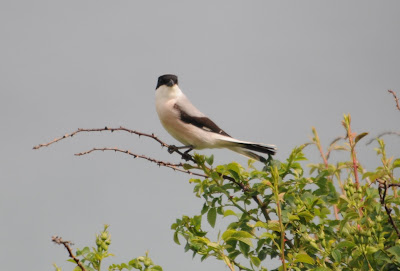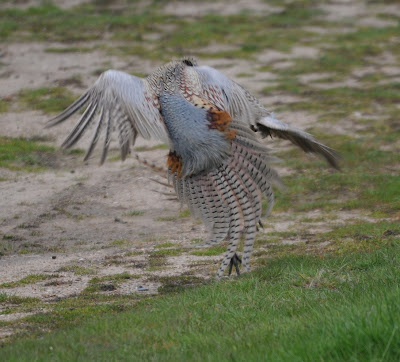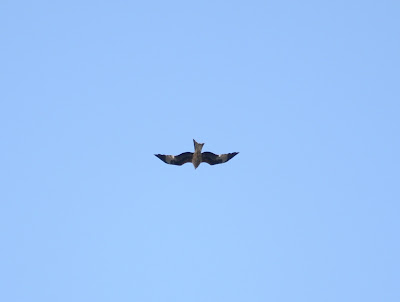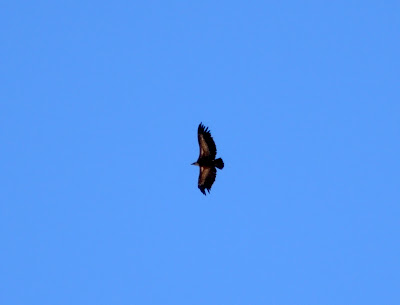Where to start, how about the best place I have ever been bird watching both in terms of species density and specialist rarities, good it was bloody brilliant.
Bulgaria is unspoilt and not effected by intensive farming; there are simply mile upon mile of grassland, some of it very steppe like along with light and heavy woodland. With wildflowers everywhere the next thing you notice is Butterflies, Fritillaries and Blues abound, with this comes the Caterpillars, they seem to be on every blade of grass or twig.
Added to this there is not a fence in sight as far as you look, it is so refreshing to look at a landscape with no man made barriers, it just adds to the wildness where ever you look. This seems to apply to everywhere, if the habitat changes all boundaries are natural.
With such a food source it is no wonder that the density of species are so high, Red Backed Shrike numbers are staggering, on one 10km stretch of road we had at least 40 birds. Black Headed and Corn Bunting are common along with Nightingale, Golden Oriole, Spanish Sparrow and Turtle Dove. Once you start entering wooded glades you become aware of Hawfinch, it is not the rarity it is in England, they often come down to roadsides to feed.
As you know I am a raptor man, this place was unbelievable; we totalled 15 species of raptor, to name a few how about, Lesser Spotted Eagle, Eastern Imperial Eagle, Long Legged Buzzard and Levant Sparrowhawk.
I could go on and on as there were so many species, our team total was 172, with my personal total being 165, this was all accomplished in just under 4 days, our guide Dancho, a great guy told us of a group of birders who recorded 214 species in 10 days, staggering in anyone’s book. I went with Jono , Bradders and Dick, like me they were first time visitors to Bulgaria, I know they were as impressed as me with Bulgaria, plans are already in place to go back again next year.
We went with Neophron Tours http://www.neophron.com/ for a short 4 day break flying out from Luton to Burgas with Wizzair.com, it’s a basic airline but I found it ok as I have little legs, needless to say the seating was a little cramped. Others in the group of the long legged variety found it tight; it got us from A TO B so ok with me.
Flight time from Luton to Burges was 3 hours, the cost around £190.00.
On arrival we were greeted by Dancho, a very nice chap and our guide, and as we were to find out, he was worth every penny. It was hectic birding as we made the most of the daylight sometimes finishing quite late due to long drives back; he also took us to specific areas which were good for photography.
It was as well we had a large minibus, which we all used as a hide to good effect, Jono’s 500mm lens took up at least 2 seats and there were times when we were all in danger of being knocked out as he tried to wield the beast.
Our 4 day tour took in the Black Sea coastline from lower Burges up to Durankulak near the Romanian border; we also headed inland for specialist sites on a number of occasions.
May 17th
Day 1
We were staying at Burges at the Hotel Mirana, this was to be our base for 2 days, a pre breakfast walk along the edge of the Black Sea produced the following. I will only list birds of note due to the fact that there were so many goodies.
Olivaceous Warbler, Night, Squacco and Purple Heron, Spanish Sparrow (common), Hawfinch, Golden Oriole, Marsh Warbler and Bee Eater were all seen in the space of 30 minutes on the shores of the Black Sea.
After breakfast we had quite a long drive to a number of specialist sites and often stopped on the way, for obvious reasons the names are not always listed in the book, birding in Eastern Europe by Gerard Gorman.
Heading along the road it soon became apparent that Red Backed Shrike, Corn and Black Headed Bunting were all common, we also pulled over on a number of occasions for raptors, you just could not avoid them. Booted Eagle, 6 Common Buzzards started the list flowing, followed shortly after by a Short Toed Eagle. The best was yet to come, as we were going along a relatively straight road, Dancho pulled up and sitting on the side of the road in a small tree was a Lesser Spotted Eagle. Incredibly the bird allowed us all to get photos as we edged nearer, it was a stunner.
Moving on and stopping at various other locations produced 7 Black Storks, Ortolan Bunting, Montagu’s Harrier, 3 Rollers and 3 Honey Buzzards. We also added 2 flocks of White Stork, 11 and 18 in number .Mixed in with the thermaling Storks were 2 Spoonbills also.
 |
| Masked Shrike |
 |
| Pygmy's |
 |
| Cormorant City |
 |
| Black Headed Bunting |
 |
Pressing on and we arrived at the first ‘specialist’ site, we located a raptor way up which was identified as an Eastern Imperial Eagle, even way up we could see it was enormous. Slightly disappointed with the views we moved on to the ‘reserve’ site, forget disappointed, the views we next had of E.I.Eagle were cracking, not one bird but 2!We even watched one of them hunting the land for their principal prey, the Souslik, more or less a ground Squirrel. It would have been very easy to stay at this site for hours, such was the attraction, you just don’t know what you are going to see next. Where ever we went we just kept seeing Bee Eaters.
We then moved on to another site and had lunch, this proved a gem of a site, Isabelline Wheatears were numerous as we drove up the track, half way up 2 Long Legged Buzzards lifted up, more life ticks. At the top after lunch we fanned out, more Black Headed Buntings, Marsh Warbler, a Barred Warbler and then 2 ‘goodies’ an Orphean and an Olive Tree Warbler.Dick did even better with brief views of a Sombre Tit, it was a cracking site.
Woodchat Shrike was also seen along the way, these were also fairly common as were Nightingale, we then arrived at a site called G.Krushovo, this was packed with not only good birds but also Butterflies.
We added Eastern Bonelli’s and Barred Warbler to the ever growing list along with Black Kite, another Short Toed Eagle and more Honey Buzzards. Syrian Woodpecker was present and we also got brief glimpses of a male Semi Collared Flycatcher.
After a while we eventually caught up with one of our target birds, a cracking Masked Shrike, this was again thanks to Dancho hearing the call, views were limited but we all saw it well enough in the dense woodland, a strange place for a Shrike.
Moving on we headed for another site, time was getting short and the weather was showing signs of closing in.Before we were deluged we added Levant Sparrowhawk, Syrian Woodpecker and Egyptian Vulture amongst the ever present Red Backed Shrikes. I understand the Egyptian was a bit of a rarity to those parts.
The 2 hour drive back to the hotel for the most part was undertaken in heavy rain, the weather was the only dampener to the trip.
 |
| For some the pace was too much...... |
 |
| Lesser Grey shrike |
 |
| Female Red Backed Shrike |
Day 2
A pre breakfast walk produced a flight of 7 Great White Egrets, Baltic Gull, Black Tern, Syrian Woodpecker, 2 Little Ringed Plovers, Olivaceous Warbler and Sandwich Tern.
Heading out after brekkie we headed for a reserve just on the fringe of Burgus, if I remember correctly it was called Atanasovsko, a series of working salt pans, it was dripping with birds and also more life ticks.
Bradders located a Broad Billed Sandpiper, eventually we ended up with 3 of them, these were tucked into a flock of 65 Curlew Sandpipers. However the first birds more or less seen, they were hard to miss, were Dalmatian Pelicans, we eventually ended up with a total of around 85.
Penduline Tit was also seen along with a late White Fronted Goose, 3 Kentish Plover, Turnstone, 8 Spoonbill and Great Reed Warbler amongst the commoner birds like Stilts and Avocets.
Moving on we stopped at the side of a busy road outside Burges, this was called Mandra, part of a reserve I believe, this also provided another lifer in the shape of a White Pelican keeping company with Dalmations.Marsh Harrier, 3 Black and 1 Whiskered Tern were hawking amongst the hordes of hirundines, Night Heron and 3 Ferruginous Ducks were also present.
Quite a spectacle and sight was the number of breeding Cormorants, they had taken over the pylons, they were disused with no cables and seemed to be on every pylon present, possibly the next step in England as they expand?
 |
| Nesting Cormorants |
 |
| Lesser Spotted Eagle |
 |
| Russian Heath |
From here we headed to a river mouth called Izvorska, not that far away from Mandra and I suspect part of the same water system.
Great Reed Warblers were immediately apparent with their loud scratchy song and we also added 5 Whiskered Terns flying through. The heavens provided a single Common Buzzard and a Booted Eagle.
There were also 2 or 3 distant raptors, possibly Buzzards, we also latched on to a small Falcon, this turned out to be an immature Hobby, we then got onto a large raptor coming towards us, even at distance it was big.
It turned itself in to a White Tailed Eagle and very conveniently landed on a rock in the middle of the lake, great views were had, it then flew and took a bird off the top of the water, possibly a Coot.
From here we then headed for the Poda Nature Reserve, another target species was seen, no less than 6 Pygmy Cormorants, these were on everyone’s wish list, although we only scoped the reserve from distance we added the following.
Marsh Harrier, 4 Squacco Herons and a Night Heron, many Great Reed Warbler, 6 Glossy Ibis’s and a number of Black Winged Stilts.
We then hit the road picking up Roller, Short Toed Eagle, White Stork, 2 Isabelline Wheatears, more Bee Eaters and 3 Marsh Harriers along the way, stopping here and there.
Eventually we came to an area on the south side of the Dinlinski Pass, not sure if I have spelt that right, a semi mountainous area and very unspoilt.
At various locations we added 4 Red Rumped Swallow. Black Stork and Honey Buzzard together, more Isabelline and Northern Wheatears, yet another Short Toed Eagle, White Wagtail, Tree Pipit, Red Backed Shrike, Nightingale, Wood Warbler and more Bee Eaters.
Jono probably got the shot of the trip here with a confiding Red Rumped Swallow that landed on his nose, check his blog.
Moving onto another site called Goritsa, we nailed 3 Semi Collared Flycatchers, Spotted Flycatcher, Nuthatch, Short Toed Treecreeper and Middle Spotted Woodpecker amongst many other of the commoner species, and again Butterflies were abundant.
 |
| Short Toed Eagle |
 |
| Long Legged Buzzard |
 |
| White Stork nest with Spanish Sparrows |
Moving on to our final site of the day as time was marching on we headed for Nos Kaliakra to a ravine for a hoped for Eagle Owl, it is listed in the Gormans book so I presume the site is publicised and well known.
The big boy never materialized but a smaller replacement turned up, a Scop’s Owl no less, a tiny substitute but good to actually see one.
We also got great views of Pied and Black Eared Wheatear and again, many Great Reed Warblers.Bradders again picked out 2 goodies, 2 summer plumed Rosy Coloured Starlings, another lifer, as you know I am not a twitcher but have always seemed to have missed them, even on the Scillies, twitcher never. We also added 4 Golden Orioles, a Marsh Warbler mimicking god knows what, half of them I didn’t have a clue on, and 3 Little Ringed Plovers on the beach was a good end to the day.
On the drive back we had a Wildcat cross the road as we headed for our 2nd hotel in Kavarna.
Day 3
This looked a bad day right from the start and so it proved as we headed for Durankulak, this was a reserve right on the coast near the Romanian border.
For the most part of the morning up until around 12.00pm we had heavy rain and lightning storms, arriving at the reserve we eventually got to an outside lean to on a beach and sea watched as well as covering the reserve.
This proved a cracking site as we ducked and dived in between rain, early birds seen were 3 Curlew Sandpipers on the beach then a small flock of 10 Little Stints, another Little Ringed Plover and 3 or 4 Black Headed Wagtails.
In between showers we moved out like the SAS, another lifer joined the ever growing list, Paddyfield Warbler, along with this there was a reeling Savi’s amongst the many Great Reed Warblers, and we even managed to see the Savi’s.
As the sun started to emerge so did the birds, a male Little Bittern, Purple Heron, a Roller, 3 Whiskered Terns, 15 Mediterranean Gulls, the thick billed race of Reed Bunting, Marsh Harrier, White Stork, 5 Squacco Herons, 7 Ferruginous ducks and a total of around 10 Black Terns. The best for me was seeing 3 White Winged Black Terns in full summer plumage up against a black stormy sky, stunning.
As we left the reserve we had a Red Footed Falcon sitting behind a post sheltering from the occasional rain showers.
 |
| Red Footed Falcons |
We then headed along the coast road to the Shabletuza Reserve, another cracking site, by now the sun was out in patches and it was looking good.
3 Golden Orioles were heard on arrival along with the ever present Great Reed Warblers, a single Marsh Harrier, and another 2 White Winged Black Terns along with at least 20 Yellow/Black Headed Wagtails were also seen.
The sun soon cleared and we started to pick up more birds, some still moving through as migrants, 6 Rollers went past, 4 Golden Orioles overhead and then a Tawny Pipit was located, a lifer no less. A small flock of Spoonbill landed on the beach and had a rest as they were flying into the wind.
A very unusual sight was seeing a Nightjar coming in off the sea located by Dick; at times it resembled a small Falcon. From here we headed up the beach, I was lagging way behind as usual, this time it paid dividends, I got onto 2 Slender Billed Gulls passing, these turned out to be the only ones of the trip. At the end of the beach we had Curlew Sandpiper, 2 Grey Plovers, Red Rumped Swallow and 2 Dunlin.
After retracing our steps we hit the road again, the coast road to Bulgarevo stopping at various spots along the road, it was here that we used the minibus as a hide and Dancho worked a blinder into getting up some cracking photos, we couldn’t fail, even me.
Along the way we picked up a pair of Red Footed Falcons, a male I have always wanted to see, joining them were Stone Curlew, Whinchat, Short Toed Lark, 5 Roller, Lesser Grey Shrike, 2 Gull Billed Terns, 2 Long Legged Buzzards, 3 Lesser Spotted Eagles, 2 Pied Wheatears, Calandra Lark and Black Necked Grebe on the sea.
By far though the stars were Bee Eater, Corn and Black Headed Bunting and quite incredible numbers of Red Backed Shrike, they seemed to be on every bush. The photography was really good and I could have easily stayed there for hours.
Our last port of call was Cape Kaliakra, this is a headland that sticks out quite a way and is obviously a migrant magnet.
During the walk to the point 10 Alpine Swifts were overhead, 3 Pied and 2 Black Eared Wheatears mingled with 2 Northerns.We then got onto a Red Breasted Flycatcher and 2 Hobbies passed.
Reaching the point, the lifer I was hoping for showed, in fact over a 100 of them, Yelkouan Shearwaters, a bit distant but the odd bird came in a little closer and gave reasonable views, we also got a couple of Shags on the rocks(no jokes please).
The last bird of the day was a Black Redstart seen in town.
 |
| Pied Wheatear |
 |
| Distant Eagle Owl |
 |
| Egyptian Vulture |
Day 4
We started the morning at Cape Kaliakra, the mixture of the 3 Wheatears were all present, Pied, Black Eared and Northern along with a very large number of Alpine Swifts, certainly 20+.
We then found an Icterine Warbler and overhead had another Hobby going over, possibly hunting the large numbers of Hirundines.We also ended up with 3 to 4 Red Breasted Flycatchers, yet to see a proper male but still a hard bird to see in England.
We then moved on to another site, and got distant views of an Eagle Owl, a bird all of us wanted to see, he or she was just resting up during the daylight hours, even at distance there was no mistaking the size of the bird, very impressive.
From here it was on to a site called Kamchia, this is listed in Gormans book and is a complex of mixed pine and deciduous woodland, very touristy.
We were after Grey Headed Woodpecker, no luck with this but we did see Middle Spotted Woodpecker, Semi Collared and Spotted Flycatcher, numerous Bee Eaters and the best of all a Sombre Tit.Unfortunately Jono missed it and despite a good search we never relocated it, with more time I suspect it would have been seen again.
We had a flight to catch so moved on again, this time taking a mountainous road to Burgas, stopping here and there. On the way we caught up with 2 Wryneck calling with 1 seen, a pale phase Booted Eagle, a single Lesser Spotted Eagle, 3 more Rollers and 2 Common Buzzards.
All in all it was without doubt the best 4 days birding I have ever had, you are simply spoilt for choice, whether it be Birds or Butterflies, when I do it again, and I will, I may go earlier to catch the main migration, especially of Raptors. The weather was not great but we still saw most of the target species, my personal list added 24 lifers, even the weather couldn’t put a stop on it. The main roads are ok for fast travel but when you leave them there are pot holes everywhere, and this applied to wherever we travelled, it is the only negative I have to say about Bulgaria.
The only thing that we paid for in the tour was beer, and that was very cheap, everything else came in the package, this included accommodation, transport, food and Dancho our guide.
I am also told that autumn migration is spectacular, might have to make it 2 trips if I can get round the wife….





























































